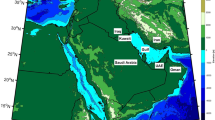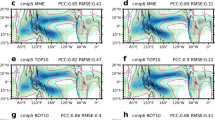Abstract
We examined the characteristic feature and predictability of low frequency variability (LFV) of the atmosphere in the Northern Hemisphere winter (January and February) by using the empirical orthogonal functions (EOFs) of the geopotential height at 500 hPa. In the discussion, we used the EOFs for geostrophic zonal wind (Uznl) and the height deviation from the zonal mean (Zeddy). The set of EOFs for Uznl and Zeddy was denoted as Uznl−1, Uznl−2, …, Zeddy−1, Zeddy−2, …, respectively. We used the data samples of 396 pentads derived from 33 years of NMC, ECMWF and JMA analyses, from January 1963 to 1995. From the calculated scores for Uznl−1, Uznl−2, Zeddy-1, Zeddy−2 and so on we found that Uznl−1 and Zeddy−1 were statistically stable and their scores were more persistent than those of the other EOFs. A close relationship existed between the scores of Uznl−1 and those of Zeddy−1.
30-day forecast experiments were carried out with the medium resolution version of JMA global spectral model for 20 cases in January and February for the period of 1984–1992. Results showed that Zeddy−1 was more predictable than the other EOFs for Zeddy.
Considering these results, we argued that prediction of the Zeddy−1 was to be one of the main target of extended-range forecasting.
Similar content being viewed by others
References
Brankovic, C, T.N. Palmer, F. Molteni, S. Tibaldi and U. Cubash (1990), Extended-range predictions with ECMWT models.Time lagged ensemble forecasting, Q.J.R.M.S., 116: 867–912.
Brankovic, C, T.N. Palmer, and L. Ferranti (1994), Predictability of seasonal atmospheric variations, J. Climate. 7: 217–237.
Branstator, G. (1984), The relationship between zonal mean flow and quasi-stationary waves in the midtroposphere, J. Atmos.Sci., 41:2163–2177.
Ferranti, L.F. Molteni and T.N. Palmer (1994), Impact of localized tropical and extratropical SST anomalies in ensembles of seasonal GCM integrations, J.R.M.S., 120: 1613–1645.
Graham, N.E., T.P. Barnet, R. White, U. Schlesse and L. Bengtsson (1994), On the role of tropical and midlatitude SSTs in forcing interannual and interdecadal variability in the winter Northern Hemisphere circulation, J. Climate., 7: 1416–1442.
Hoffman, R.N., and E. Kalnay (1983), Lagged average forecasting, an alternative to Monte Carlo forecasting, Tellus, 35A: 100–118.
Hoskins, B.J., and D. Karoly (1981), The steady linear response of a spherical atmosphere to thermal and orographie forcing, J. Atmos. Sci., 38: 1179–1196.
Kang, I.S., and N.C. Lau (1986), Principal modes of atmospheric variability in model atmosphere with and without anomaly SST forcing in the tropical Pacific, J. Atmos. Sci., 43:2719–2735.
Kawamura, R., M. Sugi and N. Sato (1994), Interannual and interdecadal atmospheric variability simulation with the JMA global model, CAS/JSC Working Group Numerical Experimentation, edited by G.J. Boer, Report No. 19, WMO, 7.25–7.26.
Kimoto, M., and K. Gambo (1988), Main leading modes of EOFs for Northern Hemisphere winter, in Japanese, presented at the Autumn Meeting of Japan Meteorological Society at Sendai, Japan.
Kitoh, A. (1988), A numerical experiment on sea surface temperature anomalies and warm winter in Japan, J. Met. Soc. Japan, 66: 515–533.
—, (1991), Interannual variations in the atmospheric GCM forced by the 1970–1989 SST, Part II: Low frequency variability of the wintertime hemispheric extratropics, J. Met. Soc. Japan, 69:271–279.
Lau, N.C., (1981), A diagnostic study of recurrent meteorological anomalies appearing in a 15-year simulation with a GFDL general circulation model. Mon. Wea. Rev., 109: 2287–2311.
Lau, N.C, and M.J. Nath (1994), A modeling study of the relative roles of tropical and extratropical SST anomalies in the variability of the global atmospheric-ocean system, J. Climate, 7:1184–1207.
Leith, C.E. (1973), The standard error of time average estimates of climatic means, J. Appl. Meteor., 11:1066–1069.
Manabe, S., and D.G. Hahn (1981), Simulation of atmospheric variability, Mon. Wea. Rev., 109: 2260–2286.
Milton, S.F., D.S. Richardson and A. Dickinson (1991), Practical extended-range dynamical forecasting at UKMO. WMO Long-range Forecasting Research Report, 14:189–192.
Molten, F., S. Tibaldi, and T.N. Palmer (1990), Regimes in the wintertime circulation over northern extratropics, I: Observational evidence, Q.J.R.M.S., 116: 30–67.
Munk, W.H. (1960), Smoothing and persistence, J. Meteorology, 17:92–93.
Palmer, T.N., C. Brankovic, F. Molteni, and S. Tibaldi, L. Ferranti, L. A. Hollingworth, U. Cubasch, and E. Klimker (1990), ECMWF program on extended-range prediction, Bull. Am. Meteorol. Soc., 74:49–65.
Palmar, T.N. (1993), Extended-range atmospheric prediction and the Lorentz model, Bull. Am. Meteorol. Soc, 71: 1317–1330.
Sugi, M., K. Kuma, K. Tada, K. Tamiya, N. Hasegawa, T. Iwasaki, S. Yamada and T. Kitade (1990), Description and performance of the JMA operational global spectral model (JMA. GSM88)., Geophys. Mag., 43: 105–130.
Tracton, M.S., K. Mo, W. Chen, E. Kalnay, R. Kistler and G. White (1989), Dynamical extended range forecasting (DERF) at the NMC, Mon. Wea. Rev., 117: 1604–1635.
Wallace, J.M. and D.S. Gutzler (1981), Teleconnection in the geopotential height field during the Northern Hemisphere winter, Mon. Wea. Rev., 112:474–490.
Yamada, S., S. Maeda, and K. Gambo (1996), Principal modes of atmospheric variability in the Northern Hemisphere winter and the role of their modes associated with the extended range forecasting, “From Atmospheric Circulation to Global Change”, edited by the Institute of Atmospheric Physics, Beijing, China.
Yamada, S., S. Maeda, T. Takano, T. Iwasaki and T. Tsuyuki (1991), Dynamical forecast experiment with the JMA global prediction model, J. Met. Soc. Japan, 69: 153–159.
Author information
Authors and Affiliations
Rights and permissions
About this article
Cite this article
Yamada, S., Maeda, S. & Gambo, K. Notes on extended–range atmospheric prediction in the Northern Hemisphere winter. Adv. Atmos. Sci. 14, 23–40 (1997). https://doi.org/10.1007/s00376-997-0040-y
Received:
Issue Date:
DOI: https://doi.org/10.1007/s00376-997-0040-y




